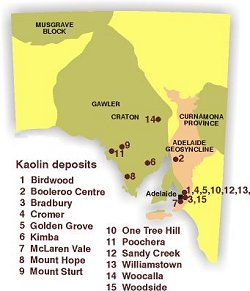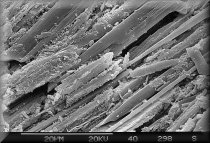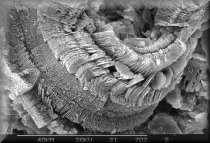 Kaolin (hydrated aluminium silicate, Al2Si2O5(OH)4) is the most important of the industrial clays in terms of both consumption and value. Properties of fine particle size, platy shape, inertness, non-toxicity, and high brightness and whiteness make it a most versatile mineral, with applications in a wide variety of industries. The largest single market, taking ~40% of production, is the paper industry where kaolin is used to fill the spaces between cellulose fibres, and as a coating agent to produce high gloss paper with good printability. Other uses include clay-based ceramics and refractories, white cement, fibreglass, and fillers and extenders in rubber, paint, plastic and adhesives. Numerous minor uses include pesticide and herbicide carriers, zeolite manufacture, catalyst supports, pharmaceuticals and cosmetics, and emerging applications in high-tech industries.
Kaolin (hydrated aluminium silicate, Al2Si2O5(OH)4) is the most important of the industrial clays in terms of both consumption and value. Properties of fine particle size, platy shape, inertness, non-toxicity, and high brightness and whiteness make it a most versatile mineral, with applications in a wide variety of industries. The largest single market, taking ~40% of production, is the paper industry where kaolin is used to fill the spaces between cellulose fibres, and as a coating agent to produce high gloss paper with good printability. Other uses include clay-based ceramics and refractories, white cement, fibreglass, and fillers and extenders in rubber, paint, plastic and adhesives. Numerous minor uses include pesticide and herbicide carriers, zeolite manufacture, catalyst supports, pharmaceuticals and cosmetics, and emerging applications in high-tech industries.
Commercial kaolin resources are found as sedimentary deposits and as weathering or hydrothermal alteration products of rocks containing a high proportion of alumino-silicate minerals.
World production is estimated to be ~46 Mt in 2020, with the largest exporters being United States, United Kingdom, Brazil and China. Past production in Australia included Comalco's Weipa kaolin operation which closed in 1996.
South Australia produced 3,400 tonnes of kaolin from Birdwood in 2013 which was used for white cement manufacture and filler applications in paint and plastics.
Considerable potential for large resources and a range of specialist products exists across the State.
Eyre Peninsula
Exploration and resource drilling on north-western Eyre Peninsula has outlined very large kaolin-(halloysite) resources in the Poochera district, including the Great White and Hammerhead deposits and Tomney, Tiger, Karcultaby, Tootla and Manta occurrences. Of these, weathered Hiltaba Suite granite in the Great White area, 15 km southwest of Poochera, has returned the highest quality kaolin, with a resource of 17.4 Mt of “bright white” kaolin identified, and total resource of kaolinised granite of 34.6 Mt (November 2020). Testwork has confirmed that kaolin from all deposits is pure, and exceptionally white, and has potential for use in high value kaolin markets.
High purity and brightness kaolin has also been identified south of Kimba on the central Eyre Peninsula and include the Caralue Bluff prospect.
There is potential to considerably expand known resources and identify new resources throughout Eyre Peninsula.
Mount Lofty Ranges
Small, high-grade kaolin deposits are mined at Williamstown and Birdwood, 40 km northeast of Adelaide. Other deposits in weathered Adelaidean rocks have been mined at Bradbury and Woodside, and in weathered Cambrian schist at Cromer.

Williamstown kaolin. Fibrous sillimanite partly replaced by kaolinite which pseudomorphs the acicular habit of sillimanite.

Birdwood kaolin. Coarse vermicular crystal of stacked kaolinite platelets.
The Williamstown deposits, currently operated by Unimin Australia Ltd, have been mined since the early 1900s as a source of kaolinite, mixed sillimanite–kaolinite (‘kaosil’), sillimanite and kyanite used mainly in the manufacture of refractories and insulators. The orebodies are metasomatic pods of massive fibrous sillimanite and coarse crystalline kyanite which have been largely altered to kaolinite by hydrothermal fluids. These are contained within an 800 m wide shear zone of highly deformed schist, gneiss and quartzite. Age of the rocks is uncertain, but they are most probably basal Burra Group equivalents of upper Aldgate Sandstone and Woolshed Flat Shale of Adelaidean age. Three orebodies have been mined; the largest is a 60 by 25 m pipe-like body which plunges steeply and extends for more than 100 m. Remaining ore reserves in these very unusual deposits are limited and production is restricted to a few thousand tonnes per year.
Birdwood
During the 1870s, high-grade kaolin masses were encountered during underground mining and prospecting for gold north of Birdwood township. Since 1886, kaolin has been mined on a small scale for ceramics, refractory bricks, industrial fillers, and cement manufacture. Kaolin formed by deep weathering of a 30 m thick quartz–biotite schist unit at the top of the Adelaidean Saddleworth Formation. The bulk of the ore is pale yellow to white sandy kaolin used in general cement manufacture. High-grade zones comprise masses of almost pure kaolin up to 50 m wide, 30 m deep and ~100 m long. Variable and unpredictable iron-oxide-stained patches dictate selective mining to produce white kaolin which is used in white cement manufacture by Adelaide Brighton Cement Ltd at Angaston and for filler applications.
Other deposits
Other kaolin deposits in weathered Adelaidean sedimentary rocks have been mined at Woocalla (north of Port Augusta) and Booleroo Centre (southeast of Port Augusta).
Sedimentary kaolin
In the Adelaide region, sedimentary kaolin was deposited in river channels and lakes draining into a much larger Gulf St Vincent which formed in early Tertiary times. The clay deposits typically form thin lenses in the Middle Eocene North Maslin Sand and comprise poorly crystalline kaolinite with variable amounts of quartz silt. The clay is moderately plastic, classed as a semi-ball clay, and gives a pale greyish or orange-pink colour when fired. It is used extensively in brick clay blends and has found limited use in the manufacture of ceramics and refractories. Largest deposits are at Golden Grove, with indicated resources of 15 Mt, and much smaller deposits are at One Tree Hill, Sandy Creek and McLaren Vale.
Additional reading
Barnes LC 1990. Williamstown kaolin–sillimanite–mica deposits. In Hughes FE ed., Geology of the mineral deposits of Australia and Papua New Guinea. Australasian Institute of Mining and Metallurgy. Monograph Series, 14:1163-1166.
Ferris GM 1993. Review of exploration for kaolin in the Kimba area, Eyre Peninsula, South Australia, Report Book 93/37. Department of Mines and Energy, South Australia.
Ferris GM and Keeling JL 1993. Review of exploration for kaolin near Poochera, northern Eyre Peninsula, South Australia, Report Book 93/18. Department of Mines and Energy, South Australia.
Keeling JL 1993. Birdwood kaolin deposits. In 10th International Clay Conference, Adelaide, 1993. Field Guide F3:6-14.
Keeling JL, Barnes LC and Conor CHH 1993. Williamstown kaolin–sillimanite–mica deposits. In 10th International Clay Conference, Adelaide, 1993. Field Guide F3:15-21.
Keeling JL, Self PG, McClure SG, Raven MD and Milnes AR 1992. Characterisation of kaolin samples from the Mount Hope deposit. Mines and Energy Review, South Australia, 158:21-26.


